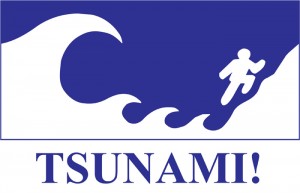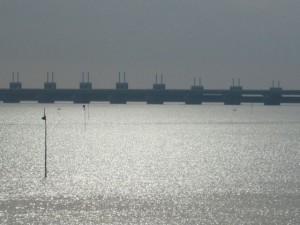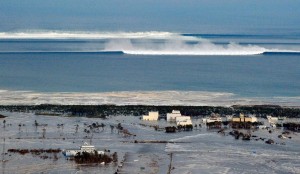As you have seen on the page Humanist Ocean Research, there is an inifinite number of possibilities for linking ocean research with humanist approaches. In international research, the focus has so far been on maritime history. However, there are many present issues within ocean research that deserve the attention of humanist research.
You will find a few examples here. Feel free to add your own and thus to make your research known to anyone interested in ocean research and the humanities.
Coastal Hazards as Source of Identity
 Presently, the Gerda Henkel Foundation finances a two-year research project on processes of identity formation through the collective experience of maritime disaster (Universität Kiel / Utrecht University).
Presently, the Gerda Henkel Foundation finances a two-year research project on processes of identity formation through the collective experience of maritime disaster (Universität Kiel / Utrecht University).
In the course of history, major flood disasters have shaped the collective memory and identity of peoples whose roots are inseparably linked to the coast and the sea. Flood disasters constitute a permanent menace. They have a devastating impact on the community. They force the residents into a continual, common effort to cope with such disasters and to protect their residential and economic environment. Thus, flood disasters crucially contribute to the identity of population groups in the endangered regions. The project examines the strategies of protection, the process of coping with coastal flood disasters and formation of identity through the common experience of such disasters over an extended period of time. This is done by taking an intercultural comparative approach to a cluster of events in the past sixty years, examining the storm floods of 1953 and 1962 in the North Sea region on the one hand and the Asian tsunamis of 2004 and 2011 on the other. The investigation puts a special focus on the change of interpretative strategies as discernable both in historical sources and in the presentation of flood disasters in film and the news media.
For more information contact: koldau@email.uni-kiel.de
Coastal Disaster – Coastal Prevention: The Zeeland Example

The Oosterschelde Storm Surge Barrier, a central and much-discussed feature of the Delta Plan (© Linda Maria Koldau)
For the Netherlands, the 1953 flood (“ramp”) with 1.836 victims and more than 100.000 people homeless for many months was a decisive event that accelerated the large-scale process of making the southern Netherlands country safe against flooding. The government’s Delta Plan, which had already been under development before 1953, was triggered off as a national project by the flood disaster, a project that was to dominate and change the entire region of Zeeland and South Holland throughout the decades to come. The Delta Plan – a large-scale project of closing the river mouths in the southern Netherlands by means of dams, sluices, and storm surge barriers, executed in the period 1954-1997 – made the region safer, reduced the coast line considerably (thus reducing the necessary efforts and costs for the maintenance of dikes) and connected the hitherto rather isolated islands of Zeeland to the urbanized Northern Randstad area, thus enhancing mobility, industrial and economic development as well as tourism.
However, in the 1970s the Delta Plan, which had so far been regarded as trend-setting national accomplishment, met severe resistance on part of newly formed environmental groups and of the Eastern Scheldt oyster and fishing industry. Eventually, the technological strategy of the Delta Works had to be revised, integrating long-term political, social and environmental perspectives, which in turn proved to be prophetic for the further, international development of water risk management.
Today, the Zeeland region is characterized by a strong awareness of identity, with regard to regional history and technological as well as ecological development. The 1953 disaster and the subsequent Delta Works appear to be ubiquitous in the region, being an integrated part of:
- education (both on primary and secondary school levels);
- collective memory (monuments, museums, oral history projects, regional media coverage of commemorations and initiatives);
- tourism (with specific cycling routes dedicated to the places of disaster and commemoration);
- development and international transfer of technology and expert knowledge in the field of water risk management (Hogeschool Zeeland founded in 2009; various smaller research institutions and laboratories in the region; regional projects in water management and aquatic ecology).
The 1953 disaster is present in the media and in various art forms – visual art, literature, drama, music, handicraft –, thus constituting of a strong awareness of regional identity, which both harks back to the 1953 event and motivates future initiatives in order to retain the desired status “Zeeland is veilig” (Zeeland is safe) [1]) in face of sea level rise and the greater frequency of extreme events.
For more information contact: koldau@email.uni-kiel.de
[1] This was the key phrase in the speech of Queen Beatrix, when she on 4 October 1986 opened the Oosterschelde storm surge barrier for use. Her assertion of final safety was essential in assuaging the trauma of the 1953 flood. “Zeeland is veilig” has since then been used as a key term in the development of the region and measures to meet climate change.
Tsunamis. Disasters, Awareness, and Prevention
Tsunamis are one of the most fascinating, but also most devastating natural disasters. Although an age-old phenomenon, this kind of maritime disaster did not enter into global awareness before the 2004 Indian Ocean tsunami that cost between 230.000 and 300.000 lives. In the past decades, natural scientists have described the various events that generate tsunamis (earthquakes, landslides, volcanic eruptions, meteorological conditions, meteorite impacts), the physical characteristics of tsunami waves, the factors influencing their impact on the coast, their run-up (maximum height ) and the subsequent inundation. Scientists, geographers, engineers and representatives from government authorities as well as local groups have done a tremendous job in improving early warning systems and preventive measures, increasing the awareness and preparedness of the population in the risk regions.
As any other natural disaster, tsunamis have had great impact on human life, human culture, and human behavior. While historical geologists have identified a considerable number of tsunamis that devastated the coasts of the continents in pre-historic times and various periods of mankind’s history, historians and humanists from various disciplines (literature, archaeology, anthropology, religious history) have described the impact of these disastrous events on societies in various cultures and various periods, from the Storegga Slide ca. 6100 B.C. up to the 2011 Tohoku Tsunami in Japan.
With the 2004 tsunami, this specific sort of natural disaster has become a regular feature in TV documentaries and feature films. A sort of natural variation of the legendary sea monster, the tsunami personifies the overwhelming power of nature, devastating mankind’s proud achievements and destroying our allegedly superior civilization within moments. Thus, a general fascination with the tsunami has developed – despite our knowledge of the tragedy this event means for the victims in every single case.
For more information cf. the book Tsunamis. Entstehung – Geschichte – Prävention (Munich: C.H. Beck, 2013) or contact koldau@email.uni-kiel.de
